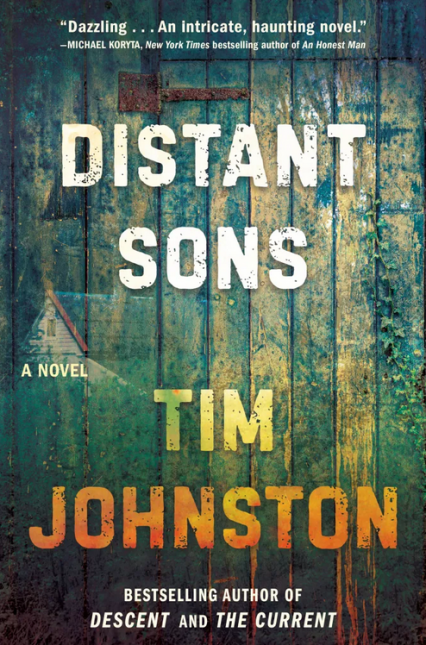Distant Sons: A Novel
- By Tim Johnston
- Algonquin Books
- 400 pp.
- Reviewed by Mark Gamin
- October 26, 2023
This exceptional whodunit deserves a sequel (and may boast a prequel).

Your Assiduous Reviewer, partial to the well-plotted literary thriller but unfamiliar with Tim Johnston, read that author’s first two novels in preparation for reviewing his third and latest, Distant Sons, and has made a preliminary assessment. Johnston is a talented and intelligent writer who avoids clichés and dead spots in his prose; a perceptive and witty creator of dialogue with the confidence to conceive the requisite (for this genre) anfractuosities and unlooked-for conclusions; and an almost-but-not-quite master craftsman, as evidenced by the unintentional loose ends he leaves here and there.
Or are they? Unintentional, that is.
In Johnston’s first novel, 2015’s Descent, the most interesting (albeit minor) character was Reed Lester, an oddball hitchhiker given a ride by the book’s hero, Sean. Lester is by turns unwholesomely ingratiating and down-home comical. In the middle of the tale, he shows up like the cavalry to save Sean from a would-be horrific assault and then disappears from the story. A loose end.
But in thinking Lester should’ve reemerged later to reprise his star turn, your A.R. got it wrong: It now appears the loose end was all part of Johnston’s plan.
Girls on the cusp of womanhood were the victims in Descent (kidnapping) and in Johnston’s second novel, 2019’s The Current (murder by drowning). Now, in Distant Sons, three little boys are the victims, with the circumstances surrounding their killing in the 1970s presented in flashback from the present day, during which the mystery is eventually solved — but only partially.
There’s no obvious connection between the first two novels, but in an ingenious bit of plotting, the duo that moves Distant Sons forward consists of the aforementioned Sean (from the first book) and Dan Young (from the second). They’re both haunted souls. Sean blames himself for the kidnapping; Dan doesn’t blame himself for the drownings but knows a lot of people do. In Distant Sons, they’re both drifting, itinerant, at loose (or dead) ends, and estranged, by choice, from their families. Perhaps that’s the provenance of the book’s title — though daughters are equally important to the narrative.
Sean’s romantic interest, Denise, is a tough waitress with red sneakers and a ponytail who lives with her Macbeth-quoting, wheelchair-bound father. The lovers’ first full conversation is a Johnstonian masterpiece, with Denise using twangy sarcasm, and Sean, she thinks, “having no idea what he was doing flirtationwise.” They both come away smitten. And Viegas, the cop who eventually (with help from Sean and Dan) finds the bodies, gets other help in the way of gnomic but essential advice from her father. She became a police detective even after her dad, who’d investigated, way back when, the little boys’ disappearance, resigned, disheartened, from the force.
Indeed, all the characters in Distant Sons are well drawn, with memorable detail. This isn’t the kind of page-turner in which keeping track of who’s who is difficult.
Surely it cannot be easy to craft multiple mysteries using not only the same characters but continuing plotlines. (Two such good ones are Steve Burrows’ “Birder Murder” series, with a hero who puts as much effort into ornithology as sleuthing, often at the same time; and Nick Herron’s mordant Slough House novels, about British spies who fight each other more than they do the bad guys.) Yet Johnston pulls it off: The awed reader eventually figures out that he’s been planning what turns out to be a large, intricate literary operation from the start. But is this the final volume in a trilogy or the third in a longer series?
There are intriguing players here seemingly unessential to the story, including a pair of barflies spouting faux French; an estranged sister briefly mentioned; and a nurse named Natukunda Jones who “one day…would be the doctor.” Are they all time bombs set to go off in volumes four, five, or six? Maybe. In any event, the loose end from two installments ago, hitchhiking rube Reed Lester (who appears only obliquely in Distant Sons), deserves his own book.
As Sean puts it, “Behind every good, the bad waited its turn.” There must be more to this saga. I say, bring it on.
It’s confounding (as your A.R. has written before) trying to figure out which of the many, many mystery/suspense/crime writers, no matter how popular, are worth the time, and which will make you rue — 15 pages from the end — the effort you’ve already put in. With so many of them cranking out novels, how can you tell?
Well, that’s what book reviews are for. So, trust your A.R.: This Tim Johnston fellow, he’s the good stuff.
Mark Gamin is a lawyer, writer, and editor. He lives sometimes in northeastern Ohio and sometimes in southeastern Ohio.

